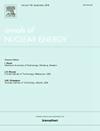Neutronic assessment of stable salt reactor with reprocessed fuels
IF 1.9
3区 工程技术
Q1 NUCLEAR SCIENCE & TECHNOLOGY
引用次数: 0
Abstract
As global energy demand is projected to increase significantly, identifying sustainable and efficient energy solutions is imperative. Small Modular Reactors (SMRs) utilizing Molten Salt Reactor (MSR) technology offer a viable approach, providing flexibility, efficiency, and reduced radioactive waste. This study examines the Stable Salt Reactor (SSR-W300), focusing on the neutronic behavior of various fuel compositions derived from PUREX (Plutonium–Uranium Redox Extraction) and UREX+ (Uranium Extraction Plus) reprocessing. The analysis utilizes the MCNP6 code to evaluate the impact of different reflector thicknesses on neutron parameters and the performance of fuels. It is determined that a 50 cm reflector thickness optimizes neutron economy while managing costs. Furthermore, comparisons of PUREX-derived fuel with UREX + fuels, which include minor actinides, reveal that UREX + fuels produce a flatter neutron flux profile and exhibit improved criticality over extended periods. The findings suggest that extending the refueling interval beyond the conventional 6 months to 8 months could enhance reactor performance. This study underscores the potential of Stable Salt Reactors (SSRs) to address growing energy demands through sustainable and efficient means.
使用后处理燃料的稳定盐堆的中子评价
由于全球能源需求预计将大幅增长,因此找到可持续和高效的能源解决方案势在必行。利用熔盐反应堆(MSR)技术的小型模块化反应堆(SMR)提供了一种可行的方法,具有灵活性、高效性和减少放射性废物的特点。本研究对稳定盐反应堆(SSR-W300)进行了研究,重点关注从 PUREX(钚铀氧化还原萃取)和 UREX+(铀萃取+)后处理中提取的各种燃料成分的中子行为。分析利用 MCNP6 代码来评估不同反射器厚度对中子参数和燃料性能的影响。结果表明,50 厘米厚的反射器既能优化中子经济性,又能控制成本。此外,对 PUREX 衍生燃料和 UREX + 燃料(包括次要锕系元素)进行比较后发现,UREX + 燃料产生的中子通量曲线更平缓,在较长时间内临界性也有所改善。研究结果表明,将换料间隔从传统的 6 个月延长到 8 个月,可以提高反应堆的性能。这项研究强调了稳定盐反应堆(SSR)通过可持续和高效的方式满足日益增长的能源需求的潜力。
本文章由计算机程序翻译,如有差异,请以英文原文为准。
求助全文
约1分钟内获得全文
求助全文
来源期刊

Annals of Nuclear Energy
工程技术-核科学技术
CiteScore
4.30
自引率
21.10%
发文量
632
审稿时长
7.3 months
期刊介绍:
Annals of Nuclear Energy provides an international medium for the communication of original research, ideas and developments in all areas of the field of nuclear energy science and technology. Its scope embraces nuclear fuel reserves, fuel cycles and cost, materials, processing, system and component technology (fission only), design and optimization, direct conversion of nuclear energy sources, environmental control, reactor physics, heat transfer and fluid dynamics, structural analysis, fuel management, future developments, nuclear fuel and safety, nuclear aerosol, neutron physics, computer technology (both software and hardware), risk assessment, radioactive waste disposal and reactor thermal hydraulics. Papers submitted to Annals need to demonstrate a clear link to nuclear power generation/nuclear engineering. Papers which deal with pure nuclear physics, pure health physics, imaging, or attenuation and shielding properties of concretes and various geological materials are not within the scope of the journal. Also, papers that deal with policy or economics are not within the scope of the journal.
 求助内容:
求助内容: 应助结果提醒方式:
应助结果提醒方式:


